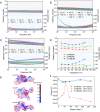High-temperature high-k polyolefin by rational molecular design
- PMID: 39642197
- PMCID: PMC11648892
- DOI: 10.1073/pnas.2415388121
High-temperature high-k polyolefin by rational molecular design
Abstract
Polymer film dielectrics are highly favored for capacitive energy storage due to the inherent advantages of high breakdown strength, low dielectric loss, and ease of processing. High-density renewables conversion and harsh-condition electrification further emphasize the need for high-temperature, high-k polymers. A unique design strategy is developed to augment high-temperature polyolefins with improved dielectric constant, via the integration of phenyl pendants hanging off the rigid bicyclic backbone. The impacts of the pendant polarizability and steric positioning on dielectric constant, bandgap, glass-transition temperature (Tg), and high-field, high-temperature dielectric characteristics have been investigated. The orientational polarization of the polar phenyl pendants with rotational degree of freedom imparts cyclic olefins with enhanced dielectric constants, while maintaining the large bandgap, and high glass-transition temperature (Tg > 170 °C). Among these synthesized polymers, m-PNB-BP stands out with a remarkable dielectric constant of 4 at a high sub-Tg temperature of 150 °C, and a high discharged density of 8.6 J/m3 at 660 MV/m. This study unveils a different path for designing high-temperature polymers with enhanced dielectric constants, particularly beneficial for capacitive energy storage.
Keywords: dielectric; energy storage; high dielectric constant; high temperature; polymer.
Conflict of interest statement
Competing interests statement:The authors declare no competing interest.
Figures





References
-
- Mannodi-Kanakkithodi A., et al. , Rational Co-design of polymer dielectrics for energy storage. Adv. Mater. 28, 6277–6291 (2016). - PubMed
-
- Rabuffi M., Picci G., Status quo and future prospects for metallized polypropylene energy storage capacitors. IEEE Trans. Plasma Sci. 30, 1939–1942 (2002).
-
- Deshmukh A. A., et al. , Flexible polyolefin dielectric by strategic design of organic modules for harsh condition electrification†. Energy Environ. Sci. 15, 1307–1314 (2022).
-
- Wu C., et al. , Rational design of all-organic flexible high-temperature polymer dielectrics. Matter 5, 2615–2623 (2022).
Grants and funding
LinkOut - more resources
Full Text Sources
Miscellaneous

